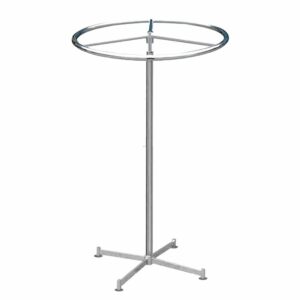These racks are essential for maximizing space efficiency in supermarkets while presenting products in a way that encourages customer engagement and increases sales.
Key Features of a Supermarket Display Rack:
- Design:
- Multi-Shelving Units: Most display racks have multiple adjustable shelves to accommodate different product sizes and quantities, from packaged goods to fresh produce.
- Vertical Space Utilization: Designed to maximize vertical space, allowing retailers to stock more products within a limited floor area.
- Pegboard/Slatwall Options: Some racks feature pegboards or slatwalls on the back for hanging products like snacks, kitchen tools, or accessories.
- Materials:
- Metal Construction: Supermarket racks are typically made from durable materials like steel or aluminum to support heavy loads and withstand high-traffic environments.
- Wire Shelving: Commonly used for displaying food items, wire shelving ensures good air circulation, ideal for perishable goods like fruits and vegetables.
- Plastic or Wood Accents: Some racks incorporate plastic or wood finishes for a more aesthetic or upscale presentation, especially in specialty sections of the store (e.g., organic produce, bakery).
- Functionality:
- Adjustable Shelves: Shelves can be adjusted to different heights to suit varying product dimensions, such as cereal boxes, canned goods, or beverage bottles.
- Signage Holders: Many supermarket display racks have built-in holders for promotional signage or pricing labels, making it easy to communicate prices, discounts, or product information to customers.
- Easy Access: Products are displayed at different levels to make them easy to reach, with the most popular or high-margin items often placed at eye level.
- Types of Supermarket Display Racks:
- Gondola Shelving: A common type of double-sided shelving used in the center of store aisles to display a variety of goods from both sides.
- End Cap Display Racks: Located at the ends of aisles, these racks are often used to promote special offers or featured products.
- Wall-Mounted Shelving: Single-sided racks attached to walls to display goods along the perimeter of the store, maximizing floor space.
- Dump Bins: Open, freestanding bins designed for displaying bulk items or promotional goods in high-traffic areas.
- Customization Options:
- Shelving Configurations: Shelves can be arranged horizontally, at an angle, or even tiered for improved product visibility.
- Add-Ons: Accessories like baskets, hooks, and dividers can be added to display small items, fresh produce, or promotional packs.
- Finishes and Colors: Racks can be customized to match the supermarket’s brand color scheme or section-specific themes (e.g., organic, imported goods, etc.).
- Special Features:
- Perforated Shelving: Some racks include perforated shelves that allow air circulation, keeping products like produce fresh.
- Wheeled Bases: For mobility, certain display racks come with wheels, making it easier to move and reconfigure displays based on seasonal promotions.
- Lighting and Signage Integration: Some high-end racks incorporate lighting to highlight products, especially in premium sections like wine, deli, or bakery.
Use Cases:
- Dry Goods: Commonly used to display boxed, canned, or packaged foods like cereals, snacks, pasta, and sauces.
- Produce: Supermarket racks with baskets or wire shelving are ideal for fresh fruits and vegetables.
- Frozen/Chilled Foods: Specialized refrigerated racks or displays are used in frozen food sections for items like ice cream, frozen meals, and dairy products.
- Bulk Goods: Racks with large bins are often used to display bulk items like grains, nuts, or candies.
Advantages:
- High Capacity: Supermarket racks are designed to hold a large number of products, helping retailers keep their stores well-stocked.
- Space Efficiency: Vertical shelving units and multi-tiered designs make the most of available floor space.
- Durable and Long-Lasting: Built to withstand the demands of a busy supermarket environment, they are made from heavy-duty materials that can support heavy product loads.
Popular Locations in Supermarkets:
- Aisle Displays: Gondola shelving is placed in the middle of aisles for bulk products and everyday essentials.
- End Caps: Used for highlighting special offers, new arrivals, or seasonal products.
- Checkout Area: Smaller racks with impulse items like candy, magazines, and drinks near checkout counters to encourage last-minute purchases.












Reviews
There are no reviews yet.